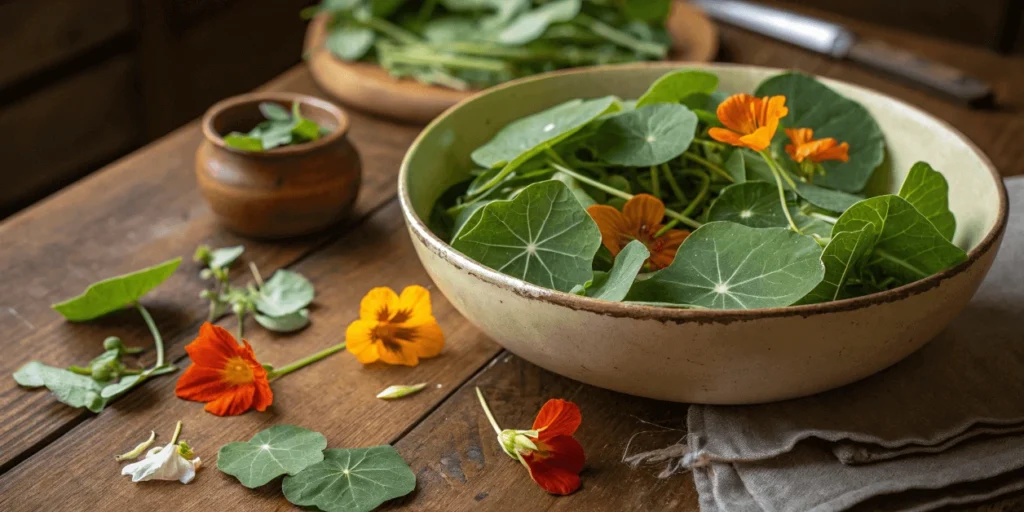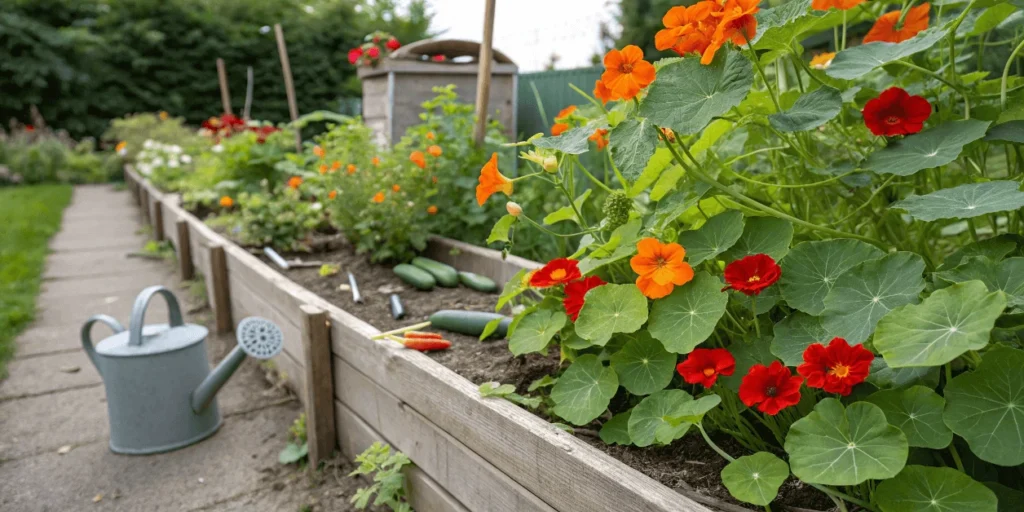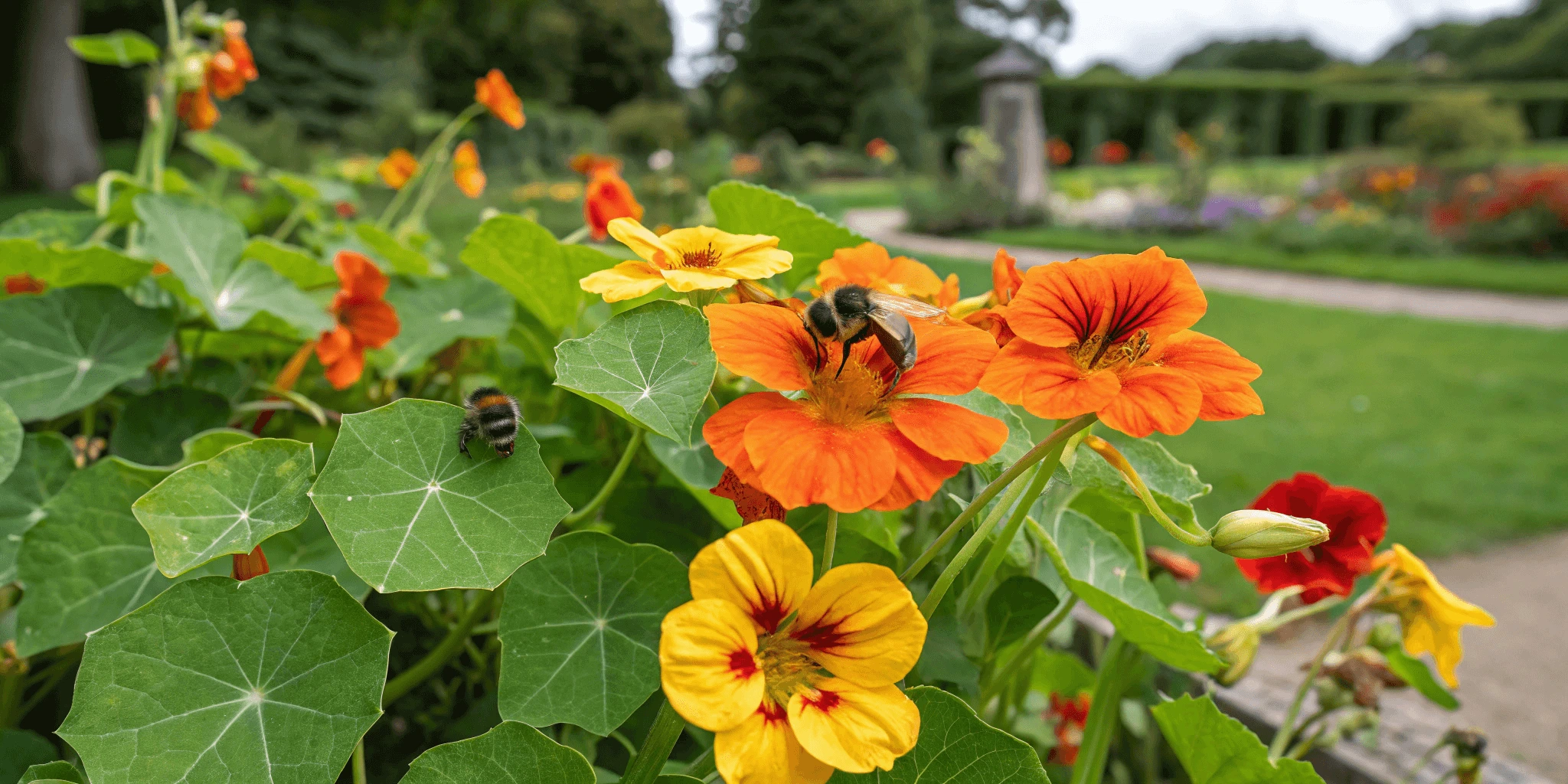Introduction
What is Nasturtium?
Nasturtium, with its Latin name Tropaeolum, is a genus of flowering plants that have captured the hearts of gardeners and chefs alike. The name “nasturtium” itself is derived from Latin, meaning “nose-twister,” a nod to its peppery scent and flavor. This genus includes several species, each with its own unique characteristics and uses. Nasturtiums are known for their bright, trumpet-shaped flowers and round, waxy leaves, making them both visually stunning and highly functional in various settings.
Common Varieties of Nasturtium
When it comes to nasturtium, variety is the spice of life. There are several species and cultivars that offer different growth habits, flower colors, and uses. The most common species is Tropaeolum majus, often referred to as the garden nasturtium. It thrives in a range of climates and produces large, showy flowers in shades of red, orange, and yellow. Another popular variety is Tropaeolum minus, which is slightly smaller and more suited for container gardens. The Tropaeolum peregrinum, or canary creeper, is known for its delicate, yellow flowers and climbing habit. Lastly, Tropaeolum speciosum, the flame flower, is a perennial variety with striking red blooms that can add a touch of drama to any garden.
Nasturtiums are both visually stunning and highly versatile. Their edible flowers and leaves make them a favorite among culinary enthusiasts, while their ability to deter pests and attract pollinators makes them a gardener’s best friend. Whether you’re looking to add a splash of color to your garden or a peppery kick to your salad, nasturtiums have got you covered.

Edible and Culinary Uses of Nasturtium
Edible Flowers and Leaves
Nasturtium is more than just a pretty face in the garden it’s also a culinary gem. All parts of the nasturtium plant are edible, including its vibrant flowers, peppery leaves, and even its seeds. The flowers add a pop of color to any dish and have a mild, peppery flavor, making them perfect for garnishing salads, cakes, and even cocktails. The leaves, with their watercress-like taste, can be used in salads, pestos, or as a fresh herb in soups and stews.
Unique Culinary Creations
One of the most interesting aspects of nasturtium is its versatility in the kitchen. For example, the seeds can be pickled and used as a caper substitute, adding a tangy, peppery kick to your favorite dishes. You can also make nasturtium vinegar by infusing the flowers in apple cider vinegar, which can then be used in dressings or marinades. Another unique idea is to create herbal butter by mixing finely chopped nasturtium leaves with softened butter, perfect for spreading on bread or adding to baked potatoes.
Garnishing and Decorations
When it comes to presentation, nasturtium truly shines. Its bright, trumpet-shaped flowers can be used to decorate cakes, adding a touch of natural beauty and a peppery twist. You can also float the flowers in bowls of soup or scatter them over a platter of cheese and crackers for a visually stunning effect. Whether you’re hosting a dinner party or simply looking to add a bit of flair to your everyday meals, nasturtium is the perfect edible decoration.
Medicinal and Health Benefits of Nasturtium
Traditional Medicinal Uses
Nasturtium has a long history of use in traditional medicine, particularly in South America. It was traditionally used to support respiratory health, thanks to its natural antibiotic and anti-inflammatory compounds. These properties make it effective in treating minor respiratory infections, such as colds and coughs. In fact, nasturtium tea is a popular remedy in many cultures.
Modern Health Benefits
Recent studies have validated numerous traditional applications of nasturtium. It is rich in bioactive compounds like vitamin C, antioxidants, and glucotropaeolin, which break down to release benzyl isothiocyanate a compound known for its antibacterial and anti-inflammatory effects. These properties not only support immune health but also help in treating minor wounds and preventing infections. Additionally, nasturtium contains flavonoids and lutein, which contribute to its antioxidant properties and may help reduce the risk of chronic diseases.
Nutritional Value
Nasturtium is a nutritional powerhouse, packed with essential vitamins and minerals. A handful of nasturtium leaves can provide over 130 mg of vitamin C, more than twice the amount found in an orange. This makes it an excellent choice for boosting immunity and supporting overall health. Whether you’re looking to add more vitamins to your diet or simply want to enjoy the many health benefits of this versatile plant, nasturtium is a great addition to your kitchen and garden.
Gardening with Nasturtium
Growing Nasturtium
Nasturtium is a gardener’s dream plant, thanks to its easy-to-grow nature and vibrant, showy flowers. Whether you’re a seasoned horticulturist or a beginner with a green thumb, nasturtiums are sure to thrive in your garden. These plants prefer well-drained soil and plenty of sunlight but can also tolerate partial shade. One of the best things about nasturtiums is that they don’t require rich soil, making them ideal for areas with less-than-perfect growing conditions. Simply sow the seeds directly into the ground after the last frost, and watch as they quickly sprout and spread. For more detailed growing tips, you can refer to this comprehensive guide .
Companion Planting with Nasturtium

One of the most fascinating aspects of nasturtium is its role as a companion plant. Nasturtiums are natural pest repellents, deterring unwanted insects like aphids and whiteflies. Their peppery scent and bright flowers also attract beneficial pollinators such as bees and butterflies, making them a valuable addition to any garden. Planting nasturtiums alongside vegetables like tomatoes, cucumbers, and beans can help protect these crops from pests while enhancing pollination. Additionally, nasturtiums can act as a trap crop, luring pests away from more vulnerable plants.
Soil Improvement and Ecosystem Benefits
Beyond their pest-repelling and pollinator-attracting abilities, nasturtiums also contribute to soil health. Their extensive root systems help break up compacted soil, improving aeration and drainage. This makes them particularly useful in areas with heavy or clayey soil. Moreover, nasturtiums are known to enrich the soil with organic matter as they decompose, creating a more fertile environment for future plantings. By adding beauty, functionality, and ecological benefits to your garden, nasturtiums truly are a gardener’s best friend.
For more tips on gardening and companion planting, check out our article on campanion planting techniques.
Nasturtium in Modern Research
Recent Studies
In recent years, nasturtium has garnered attention from researchers for its unique properties and potential applications. Studies have shown that nasturtiums can thrive in saline conditions, making them a promising candidate for cultivation in areas affected by soil salinity. One notable study highlighted the role of proline, an amino acid, in helping nasturtiums tolerate high salinity levels. This research not only sheds light on the plant’s adaptability but also opens up possibilities for its use in semi-arid regions.
Biochemical and Physiological Insights
Modern research has also delved into the biochemical and physiological aspects of nasturtium. Studies have found that nasturtiums exhibit remarkable resilience under stress, with their gas exchange and photosynthesis processes remaining efficient even in challenging conditions. This adaptability is partly due to the presence of bioactive compounds like glucotropaeolin, which break down to release benzyl isothiocyanate. This compound not only provides the plant with natural defense mechanisms but also enhances its overall growth and biomass production.
Future Potential
As researchers continue to explore the potential of nasturtium, its applications in agriculture and medicine are becoming more evident. The plant’s ability to grow in saline soils could be particularly valuable in regions facing water scarcity and soil degradation. Additionally, its rich content of bioactive compounds offers potential for developing natural pesticides and pharmaceuticals. With ongoing studies and advancements, nasturtiums may soon play a more significant role in sustainable agriculture and health solutions.
For more information on the latest research in plant science, visit our plant research articles.
Fun Facts and Miscellaneous Information
Interesting Facts About Nasturtium
Nasturtium is more than just a beautiful plant it’s also full of surprises. For starters, its name comes from the Latin words “nas” and “tortus,” meaning “twisted nose,” a playful reference to the peppery scent that can make your nose tingle. This unique characteristic has made nasturtium a favorite in both gardens and kitchens. But did you know that nasturtiums were once used as a symbol of victory in ancient times? The plant’s bright, trumpet-shaped flowers were thought to resemble the trophies of war, giving it a symbolic meaning that has endured for centuries.
Color Varieties and Growing Habits
When it comes to nasturtium, variety is truly the spice of life. These plants come in a wide range of colors, from fiery reds and oranges to soft yellows and creams. Whether you’re looking for a pop of color in your garden or a subtle touch of elegance, there’s a nasturtium variety to suit your needs. Additionally, nasturtiums can be annual or perennial, depending on the species. For example, Tropaeolum majus is an annual that thrives in temperate climates, while Tropaeolum speciosum is a perennial that can add a touch of drama with its climbing habit. No matter which type you choose, nasturtiums are sure to bring beauty and versatility to your garden.
FAQs
What are the best uses for nasturtium in the kitchen?
Nasturtium is a culinary powerhouse, with edible flowers, leaves, and even seeds. The flowers add a peppery kick and vibrant color to salads, while the leaves can be used in pestos or as a fresh herb in soups. For a unique twist, try pickling the seeds as a caper substitute or making nasturtium vinegar for dressings. You can also use the flowers to garnish cakes or float them in soup for a beautiful presentation.
How can nasturtium benefit my garden?
Nasturtium is a gardener’s best friend. It acts as a natural pest repellent, deterring aphids and other unwanted insects. At the same time, its bright flowers attract pollinators like bees and butterflies, boosting the health of your garden. Nasturtiums also help break up compacted soil, improving aeration and drainage. Plus, they add a splash of color and visual interest to any garden space.
Is nasturtium safe for consumption?
Absolutely! All parts of the nasturtium plant are edible and safe to consume. However, as with any plant, it’s important to ensure that your nasturtiums are grown without pesticides or other harmful chemicals. If you’re foraging from the wild, make sure to identify the plant correctly to avoid any mix-ups.
What are the ideal growing conditions ?
Nasturtium is a hardy plant that thrives in well-drained soil and full sun. However, it can also tolerate partial shade and less-than-perfect soil conditions. Simply sow the seeds directly into the ground after the last frost, and watch them grow. Nasturtiums are relatively low-maintenance, making them perfect for both beginner and experienced gardener
Conclusion
Summing Up the Wonders of Nasturtium
As we wrap up our exploration of nasturtium, it’s clear that this humble plant is anything but ordinary. From its vibrant, edible flowers to its peppery leaves and medicinal properties, nasturtium offers a wealth of benefits for both the garden and the kitchen. Whether you’re using it to deter pests, attract pollinators, or add a unique flavor to your meals, nasturtium is a versatile and valuable addition to any space. Its ability to thrive in less-than-ideal conditions and its rich nutritional profile make it a standout choice for gardeners and health enthusiasts alike.
Looking Ahead with Nasturtium
With ongoing research uncovering new potential uses for nasturtium, the future looks bright for this remarkable plant. Its adaptability to saline soils and its role in sustainable agriculture highlight its importance in a changing world. Whether you’re growing it for its beauty, harvesting it for its culinary delights, or exploring its medicinal properties, nasturtium is sure to continue making waves. So why not give it a try? Plant some nasturtiums in your garden or experiment with new recipes your taste buds and garden will thank you!
Additional Resources and Further Reading
Where to Learn More
If you’re eager to dive deeper into the world of nasturtium, there are plenty of resources available to help you. From gardening guides to culinary inspiration, the internet is full of valuable information. For detailed growing tips and companion planting ideas, check out gardening blogs and forums where experienced gardeners share their insights. If you’re interested in the medicinal properties of nasturtium, scientific journals and health websites often publish the latest research findings.
Recipes and Creative Uses
For those looking to explore the culinary side of nasturtium, recipe websites and cookbooks dedicated to edible flowers can provide endless inspiration. Try searching for nasturtium pesto recipes, pickled seed ideas, or floral cocktail garnishes. You might also find local workshops or cooking classes that focus on using edible flowers in unique ways. Whether you’re a gardener, a chef, or simply a curious plant lover, there’s always more to discover about this versatile and fascinating plant.

